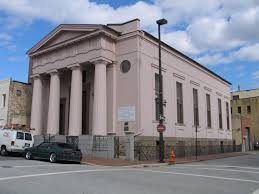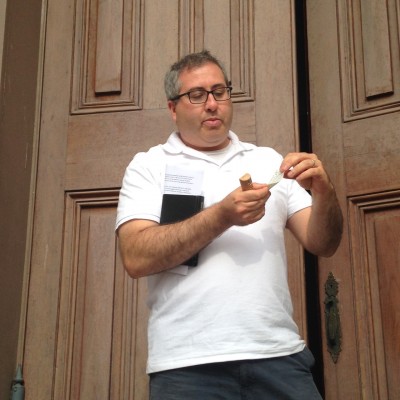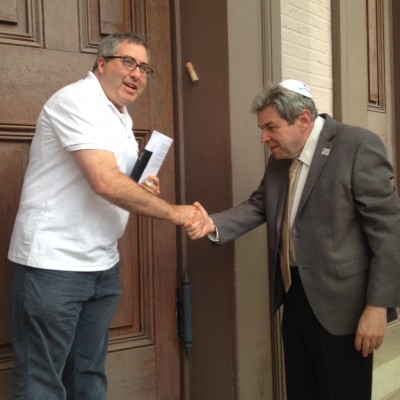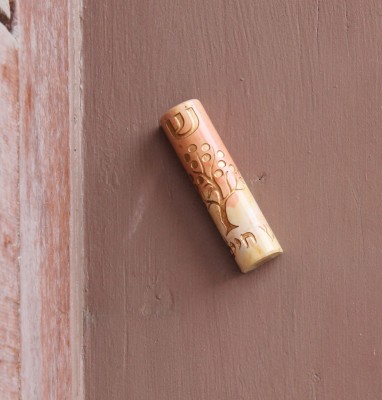Hanukkat in the Lloyd Street Synagogue

Last week I observed a beautiful moment for the Jewish Museum of Maryland and we are not ready for the Festival of Lights yet! For the past 10 years there was no mezuzah affixed to the doorpost of the Lloyd Street Synagogue. When the building went under renovations roughly 10 years ago, the mezuzah that had been on the building had been misplaced. The beautiful moment I witnessed was the mezuzah being affixed once again to the building- or a Hanukkat (Dedication) of the Lloyd Street Synagogue.

The mezuzah is of biblical origin and there is reference to it in the Torah or Five Books of Moses. “And you shall inscribe them on the doorposts (mezuzot) of our house and on your gates” (Deuteronomy 6:9, 11:20). What is to be inscribed? The passage reads, “The words that I shall tell you this day”: that you shall love your God, believe only in Him, keep His commandments, and pass all of this on to your children.
An important part of the mezuzah refers to the parchment inside, or klaf, on which the verses of the Torah are inscribed. The klaf must be hand-lettered by a kosher scribe — one who is observant of halakha (Jewish law) and who qualifies for the task. The scroll is rolled up from left to right so that when it is unrolled the first words appear first. The scroll is inserted into the container but should not be permanently sealed because twice in seven years the parchment should be opened and inspected to see if any of the letters have faded or become damaged.
A mezuzah serves two functions: Every time you enter or leave, the mezuzah reminds you that you have a covenant with God; second, the mezuzah serves as a symbol to everyone else that this particular dwelling is constituted as a Jewish household, operating by a special set of rules, rituals, and beliefs.

Rabbi Eitan Mintz helped us with the dedication ceremony and shared with us some interesting facts about the placement of a mezuzah. Many Jews tilt the mezuzah so that the top slants toward the room into which the door opens. This is done to accommodate the variant opinions of the great Jewish thinkers Rashi and of his grandson, Rabbeinu Tam, as to whether the mezuzah should be placed vertically (Rashi) or horizontally (Rabbeinu Tam). The compromise solution (top slant) was suggested by Rabbi Jacob ben Asher.

JMM Executive Director, Marvin Pinkert held the mezuzah against the spot upon which it is now affixed, and we all recited the blessing in Hebrew…
בָּרוּךְ אַתָּה יי אֱלֹהֵינוּ מֶלֶךְ הָעוֹלָם, אֲשֶׁר קִדְּשַׁנוּ בְּמִצְוֹתָיו וְצִוָּנוּ לִקְבּוֹעַ מְזוּזָה
Barukh atah Adonai Eloheinu melekh ha‘olam, asher kideshanu bemitzvotav vetzivanu liqboa‘ mezuzah.
Blessed are You, Lord our God, King of the Universe, Who sanctified us with His mitzvot and commanded us to affix a mezuzah.

We hope that you will come down to the JMM to see our new mezuzah in the Lloyd Street Synagogue and other recent additions to the space.
 A blog post by Education Director Ilene Dackman-Alon. To read more posts by Ilene click HERE.
A blog post by Education Director Ilene Dackman-Alon. To read more posts by Ilene click HERE.
